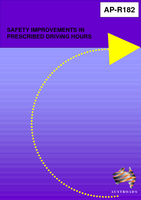Freight

Safety Improvements in Prescribed Driving Hours
- Publication no: AP-R182-01
- ISBN: 0 85588 575 0
- Published: 1 January 2001
- PDF (free) Download
This report examines whether road safety benefits can be delivered through a more flexible approach to restrictions on prescriptive driving hours without adding unwarranted costs to road transport services. To do this, differential treatment of night-time driving under prescriptive driving hours is considered. Three types of flexibility are investigated: Flexibility to complete trips is intended to allow a certain amount of flexibility to drive further to reach a destination where better sleep can be gained. A disincentive is suggested to take double the added time off the following daily limit. Flexibility in short rest breaks is intended to allow operational flexibility in the timing of short breaks. Weighting of night time driving is investigated as a means of taking account of driving undertaken during the high risk periods of the circadian cycle. The weighted system acts to limit night hours of driving while extending driving times during daylight hours. The report finds that the addition of flexibility approaches to prescriptive driving hours regulations may lead to improved road safety outcomes and should be considered.
- AP-R182/01 SAFETY IMPROVEMENTS IN PRESCRIBED DRIVING HOURS
- Summary
- Table of Contents
- 1. INTRODUCTION
- 2. RESEARCH METHODOLOGY
- 3. RESEARCH ON DRIVER FATIGUE
- 4. CHANGING CURRENT REGULATIONS
- 5. ISSUES FOR DISCUSSION
- 6. INCREASED FLEXIBILITY IN REGULATED HOURS
- 7. WEIGHTING PRESCRIBED DRIVING HOURS
- 8. IMPLICATIONS OF PROPOSED CHANGES
- 9. CONCLUSION AND PROPOSALS FOR CHANGE
- 10. REFERENCES
- APPENDIX A - Focus Group Participants
- APPENDIX B - Focus Group Workbook
- APPENDIX C - Focus Group Responses
- APPENDIX D - Comments from Fatigue Experts
Related publications
WEB-R703-24
Latest Freight News
